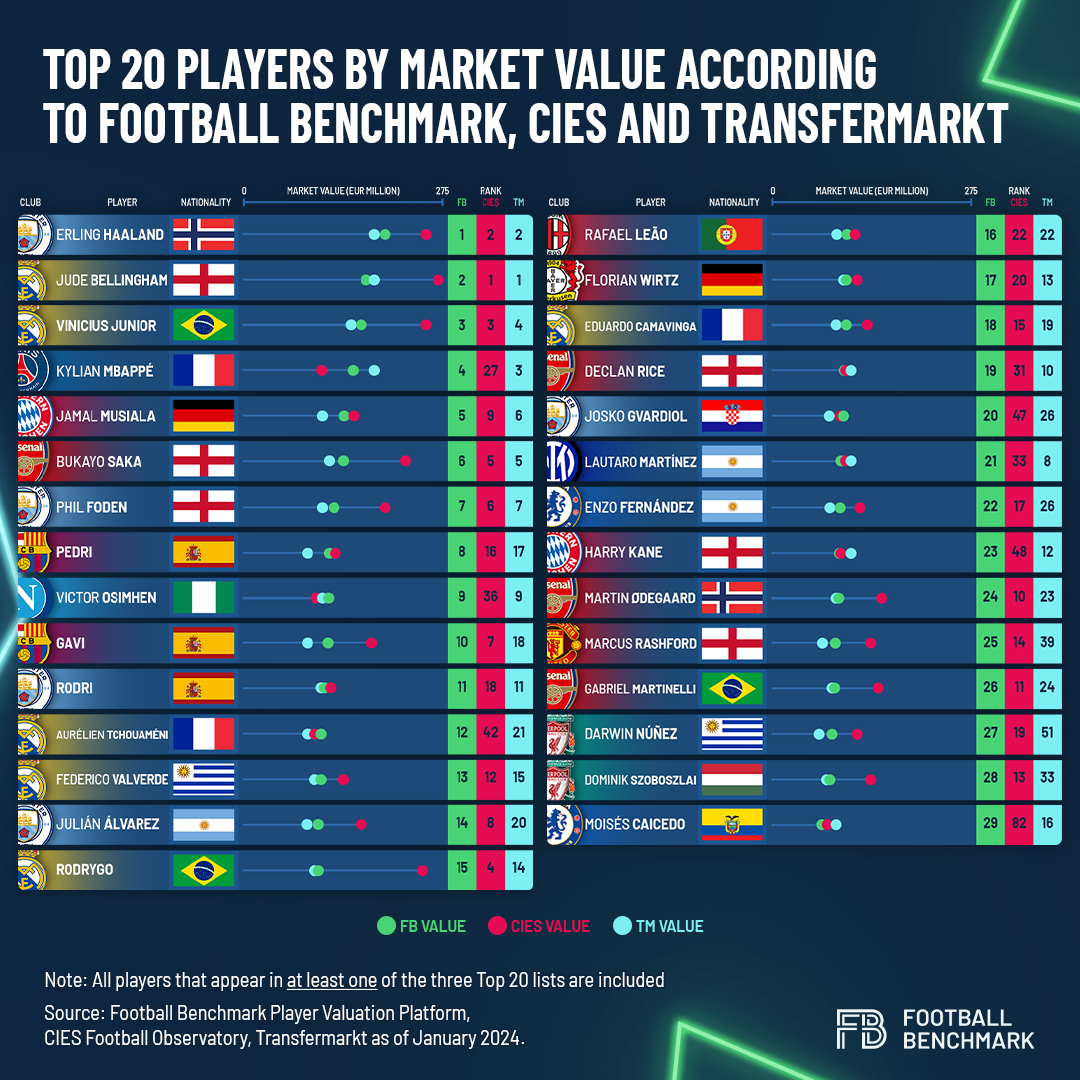The beginning of the new year also brings the opening of the January transfer window in many leading football leagues, offering each team a chance to adjust their playing squads. These moves generally include signings to replace injured or underperforming players, strengthen the squad to avoid relegation or achieve other sporting goals. Furthermore, clubs can also start negotiations with players who have less than six months left on their current contracts, with some big names able to agree to moves already for next season.
In periods like this, the fair valuation of players’ registrations becomes ever more important. At Football Benchmark, we have been providing estimated fair market values for thousands of players since 2018, using our proprietary algorithm that considers player, club, and market characteristics. Nevertheless, several other prominent organizations offer similar insights. Let's use this opportunity to explore and compare market values from sources like Football Benchmark, the CIES Football Observatory, and Transfermarkt.
One player, three different perspectives on their market value
Market values are often hotly debated in the football industry. While naturally every fan, coach, and sporting director have their own strong opinions on the worth of a player, these debates are also rooted in methodology differences when attempting to estimate the fair market value of footballers, the most valuable assets of football clubs.
Notable distinctions lie in the approaches adopted by Football Benchmark, CIES and Transfermarkt, too. While the latter is known for user-generated content, and their valuations often reflect collective opinions and discussions, both CIES and Football Benchmark rely on data-driven analytics and statistical models to assess player values, perhaps resulting in a more objective valuation. Based on the information at our disposal, the main difference between the two is that in the case of CIES, the values refer to 100% of the economic rights and include both fixed and conditional sums (add-ons), while Football Benchmark’s valuations exclude the variable component. Additional differences are also a result of which on-pitch performance, player or club metrics are part of the statistical model and what weights are assigned to them. For more details about the Football Benchmark approach, please click here.
Regarding sporting metrics, it should be noted that data suppliers also have unique data collection processes. While goals scored maintain a consistent definition across data companies, other metrics such as key passes or successful dribbles exhibit more variability, potentially yielding different results.
Despite the valuable insights different platforms provide in assessing player market values, it is essential to recognize inherent limitations and challenges. At Football Benchmark, we believe that it is fundamental to distinguish between the concepts of price and value and this is considered in our applied methodology. Price is defined as the amount a person or company pays for a particular product or service, whereas value represents the intrinsic worth of that product or service. If we translate this to transfer market and player valuation in football, the actual transfer fees observed might deviate from the fundamental concept of value due to various influencing factors. These factors include the unique financial and sporting circumstances of both the seller and the buyer at the time of the transaction. Additionally, the willingness of a player to either depart from or join a club can significantly impact the final transfer fee. League-specific rules and regulations, terms stipulated in release clauses, and the influence or interests of agents further contribute to the complexity of determining a fair value. Emotional considerations, stemming from the players, clubs, media or even fans, can also play a role in shaping the perceived worth of a player in the transfer market. Consequently, the actual transfer fee often reflects a multifaceted interplay of these diverse elements rather than a straightforward representation of the intrinsic value of the player.
Most valuable players of each platform (January 2024, EUR million)
For the comparison exercise, we selected the top 20 most valuable players according to Football Benchmark, CIES and Transfermarkt. These values were all sourced in early January 2024.

There are familiar names like Erling Haaland, Jude Bellingham, and Vinicius Jr that are consistently near the top of all three lists. In total, 14 players appear in all three rankings, albeit their order shows significant variance. Another similarity is that all three lists mainly feature players with contracts running beyond 2027 and also include a wide range of nationalities reflecting the global diversity of football talent. In terms of positional representation, each list features mostly forwards and midfielders, with Football Benchmark being the only one that has a defender among the top 20 (Josko Gvardiol of Manchester City FC ranked 20th). Interestingly, the CIES list is skewed heavily towards English Premier League players, making up 50% of the top 20. There are also zero players from the French Ligue 1 and the Italian Serie A in their list. Conversely, Football Benchmark and Transfermarkt display a more balanced distribution across the European “Big Five” leagues.
When considering the combined market value of the top 20 players, the CIES list stands out with a substantial figure surpassing EUR 3.38 billion, whereas Football Benchmark and Transfermarkt are at EUR 2.49 billion and EUR 2.33 billion, respectively. The significant discrepancy is partially explained by the methodology difference with CIES also considering variable/conditional sums in their value estimates.
“Hundred million” club
The overall revenue generated by football clubs has significantly increased over the past decades, partly due to lucrative broadcasting deals, sponsorships, and commercial partnerships. Top clubs have more financial resources, allowing them to spend large sums on player transfers. This influx of financial resources has contributed to the inflation of transfer fees over the years. In the last two seasons, following the impact of the COVID-19 pandemic, there were five transfers reportedly exceeding EUR 100 million, bringing the all-time total of such transfers to 16. How many more “blockbuster” transfers of similar values can be expected in the future? To give an indication, let’s compare how many players are valued at or above EUR 100 million.
There is a considerable difference in views in this regard. Upon analysing the latest data from the three sources, we found that Transfermarkt currently has the fewest with 15, followed by Football Benchmark with 19 and CIES with 39 players valued at EUR 100+ million. The impending free agency of Kylian Mbappé adds a unique dimension to this landscape. Despite his short remaining contract duration (until 30 June 2024), all three outlets still value him above EUR 100 million. However, it should be noted that according to the Football Benchmark methodology, his estimated value will be zero after the close of the winter transfer window. This is due to the fact that he can negotiate a new contract with a club starting from July, with no fee attached to his transfer .
Our team at Football Benchmark closely monitors developments in the transfer market and football finance to provide accurate valuations aiming to reflect fair market values. It is important to note that the number of clubs with the capacity to invest significant amounts in a single player transfer is limited. These high-value transfers account for a substantial portion of a club's revenue, and the long-term commitment in the form of the players' salaries must also be considered. It is crucial to emphasize that players valued at EUR 100 million or more remain a rarity, requiring substantial investment and meticulous planning from clubs.
Football Benchmark remains committed to provide independent values, offering an objective assessment of a player's economic worth that considers the “market reality”.
Our objective is to support clubs in making informed choices about player acquisitions and contribute to a more strategic and effective approach in managing their squads.



